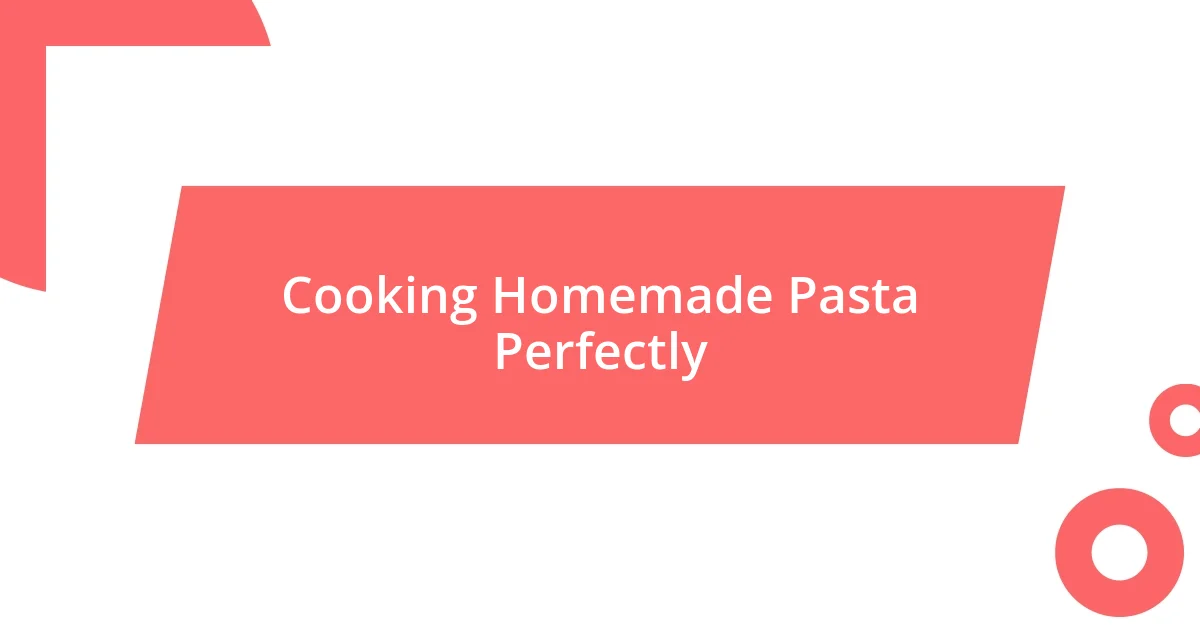Key takeaways:
- Choosing the right flour, such as durum wheat or 00 flour, is crucial for achieving the desired texture and quality in homemade pasta.
- Incorporating fresh ingredients, like eggs and quality salt in cooking water, significantly enhances flavor and overall dish quality.
- Proper kneading techniques and careful storage methods are essential for creating and maintaining the perfect pasta consistency.

Choosing the Right Flour
When it comes to choosing the right flour for homemade pasta, I’ve discovered that not all flours are created equal. For instance, durum wheat flour is a go-to for many pasta enthusiasts because it has a high protein content, lending your pasta that lovely firm texture. Isn’t it fascinating how a simple choice can elevate your dish from ordinary to extraordinary?
I remember the first time I experimented with all-purpose flour instead of semolina for my pasta. The result was a softer, less chewy product that, while still tasty, just didn’t have the same character. Have you ever had a similar experience? It made me realize how crucial flour selection is in achieving the desired pasta quality.
Finally, I often recommend trying different blends to find what resonates most with your palate. A combination of 00 flour and semolina can create a delightful balance of tenderness and structure. Isn’t it exciting to explore how various flours can transform your culinary experiences? Each grain opens up a world of possibilities, inviting your taste buds on a journey.

Understanding Pasta Ingredients
The story of making pasta isn’t just about choosing the right flour; it also revolves around the other essential ingredients. For instance, using fresh eggs instead of water can make a world of difference. I was astonished the first time I cracked open an egg from my local farmer’s market, the yolk so vibrant and rich. This small change turned my pasta dough into something incredibly luxurious and flavorful. It’s thrilling how the quality of a simple ingredient can elevate an entire dish.
Here are the key ingredients to consider when making homemade pasta:
- Flour: Durum wheat for firmness or 00 flour for tenderness.
- Eggs: Fresh, quality eggs create a richer flavor and richer color.
- Water: Essential for hydration; avoid overdoing it to prevent a sticky dough.
- Salt: Enhances flavor, but be mindful of the quantity.
- Olive Oil: Adding a touch can improve texture and make the dough more manageable.
Experimenting with these ingredients added not only depth to my pasta but also joy to the process. It’s as if every choice is an invitation to discover something new in your cooking journey. Have you felt that spark when you find an ingredient that just clicks? It’s pure magic.

Kneading Techniques for Dough
Kneading the dough is where the magic truly begins. It’s fascinating how this simple process can transform a pile of ingredients into silky, cohesive pasta. When I first started making pasta, I was overly cautious, barely kneading the dough at all. But after attending a workshop, I learned that kneading releases gluten, which is essential for giving the pasta its structure. I could feel the difference when I finally started kneading vigorously. The dough became so smooth and elastic—it was a real game-changer!
There are a couple of techniques I’ve found incredibly helpful for effective kneading. The push fold method has become a favorite of mine. You push the dough away with the heels of your hands, then fold it back over itself. It’s rhythmic and satisfying, almost therapeutic. I remember one peaceful afternoon, the sunlight streaming in as I kneaded—with each push, I felt a sense of calm washing over me. And when I finally shaped the dough into pasta, the texture was just perfect. Have you ever felt so connected to your food in that way?
When you’re ready to develop that perfect dough, the timing is crucial. Aim for about 10 minutes of kneading, but trust your instincts; you’ll know it’s ready when it feels smooth and elastic—almost like a soft pillow. It’s like developing a friendship; the more you engage, the stronger your bond becomes. Here’s a quick comparison of different kneading techniques:
| Kneading Technique | Description |
|---|---|
| Push Fold | Using heels of hands, push dough away, then fold it over. |
| Pinching | Pinch and fold the dough; great for incorporating ingredients. |
| Slap and Fold | Slap dough on the counter, fold, and repeat; creates strong structure. |

Shaping Various Pasta Types
Shaping pasta can feel like an artistry in your own kitchen, and honestly, every type has its own charm. The first time I tried making fettuccine, I remember feeling a bit intimidated by the thinness and precision required. I rolled out the dough to about 1/8 inch thick and then used my sharp knife to cut perfect strips. Watching those beautiful ribbons take shape was thrilling! Have you ever experienced that pride when your effort pays off?
And then there’s the joy of creating stuffed pasta like ravioli. I often reminisce about that cozy Sunday afternoon when I invited friends over for a pasta-making session. We rolled out the dough together, and our laughter filled the kitchen. We filled our rounds with ricotta and spinach, crimping the edges with our fingers. That tactile experience of sealing each pocket was both satisfying and a tad nostalgic, reminding me of family gatherings. Doesn’t it feel rewarding when a simple dish brings people together in such a rich way?
Of course, let’s not forget about shapes like orecchiette, which simply requires pinching small pieces of dough. I was surprised at how quickly I mastered that technique! With just a little practice, my thumb created those little ear-shaped pasta, each perfectly imperfect. It astonished me how much personality each piece held. It’s those tiny details that make homemade pasta truly a labor of love, don’t you think?

Cooking Homemade Pasta Perfectly
Cooking homemade pasta to perfection is more than just boiling water and adding noodles; it’s an art form that requires attention to detail and a touch of intuition. When I first started, I would often test my pasta’s doneness by tossing a piece against the wall—ridiculous, I know, but it felt exciting in a way! Now, I rely on the classic method of tasting a strand. The perfect al dente pasta should have a slight bite to it, creating a delightful contrast with any sauce. Can you recall a time when a simple taste gave you that pleasurable surprise?
One essential tip I’ve picked up is the importance of salt in the cooking water. It should taste like the sea—it sounds dramatic, but trust me, it transforms the overall flavor of your dish. I remember the first time I skipped this step, thinking it wouldn’t matter. The pasta was bland and sad. Now, I like to add the salt as soon as I bring the water to a boil, and the way the taste blossoms is genuinely rewarding. It’s like the pasta has been given a new life, don’t you think?
Finally, let’s talk about the timing for mixing the pasta with the sauce. Here’s a golden nugget of wisdom: I’ve found that finishing the pasta cooking right in the sauce, just for a minute or two, allows those flavors to marry beautifully. The first time I did this was an eye-opener; my pasta absorbed the sauce so much better! It’s as if each strand became a part of the dish, enhancing the overall experience. How do you prefer to finish your pasta? The little adjustments can make all the difference!

Storing and Freezing Pasta
Storing homemade pasta properly is essential to maintain its freshness and flavor. I’ve learned the hard way that simply tossing it in a bowl doesn’t cut it. The first time I overcooked some pasta because I didn’t store it correctly, I promised myself to be more diligent. To store fresh pasta, I like to sprinkle a bit of flour on it and arrange it in nests. This method prevents it from sticking together, making it easier to grab a portion when I’m ready to cook.
When it comes to freezing pasta, I often wonder why I didn’t start doing it sooner! Just a few weeks back, I made a big batch of gnocchi and was thrilled to discover how easy it is. After shaping them, I laid the gnocchi on a baking sheet lined with parchment paper and placed it in the freezer for a couple of hours. Once they were frozen solid, I transferred them to a zip-lock bag. Now, I can grab just what I need for a cozy weeknight dinner without the fuss of starting from scratch every time. Doesn’t that sound convenient?
Thawing frozen pasta can be a bit tricky, though. I remember once, I forgot to take a bag out of the freezer and was left scrambling for a quick dinner. I’ve since learned that adding frozen pasta directly to boiling water is the best method. It cooks beautifully without compromising texture or flavor. Have you ever had that “aha” moment where you discover a method that simplifies your routine? I find it incredible how small changes can enhance the cooking experience.

Creative Pasta Recipes to Try
One of my favorite creative pasta recipes to whip up is a lemon-basil fettuccine. The first time I made it, I was taken aback by how a simple zest of lemon could awaken the entire dish. It’s like a burst of sunshine on your plate! I toss freshly made fettuccine with olive oil, a sprinkle of lemon zest, and freshly chopped basil. The taste is incredibly refreshing, and it pairs wonderfully with grilled chicken or shrimp. Can you think of a time when a little twist in flavor made all the difference for you?
If you’re on the adventurous side, why not try making a squid ink pasta? Initially, I was intimidated by the dark color and the potential fishy flavor. However, after a friend guided me through it, I discovered an explosion of unique flavors. The squid ink imparts a distinctly marine taste to the pasta, which contrasts beautifully with a garlic and seafood sauce. It’s an impressive dish to serve at dinner parties, and you might find your guests raving about it! Isn’t it fascinating how ingredients can elevate your cooking?
For something comforting and hearty, I highly recommend a sweet potato gnocchi with sage brown butter. The first time I tried this combination, it was love at first bite. The sweetness of the potato paired with the nuttiness of the brown butter is a match made in heaven. I remember savoring every bite, feeling the warmth of fall with each forkful. Plus, making gnocchi from scratch is almost therapeutic and incredibly fulfilling! Have you ever let a dish transport you to a different time or place?















